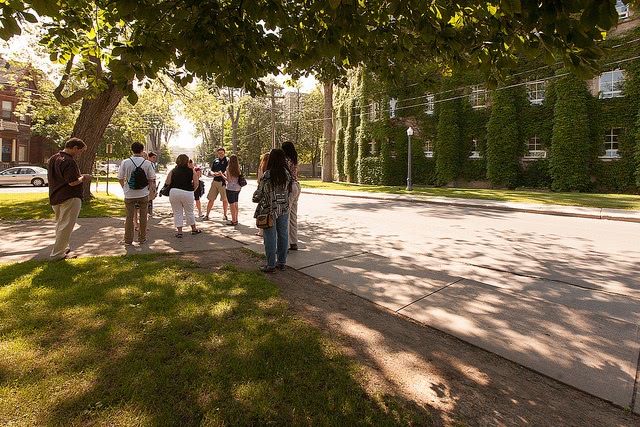- Paying for college with no savings is still possible when you consider cutting back your discretionary costs, working part time, taking classes at community college and considering more affordable college options.
- Several financial aid resources are available for college students including FAFSA, state grants, and scholarship programs.
- Private student loans are an option to help pay for college when grants, scholarships and other forms of aid are not enough.
For families across America it can be difficult to save for their children’s college. Some start saving a little too late and struggle to close the gap when it’s time for college. Others start saving when their child is born but life gets in the way of saving for college. A health crisis, job loss, bad investments, or divorce can make a dent in any family’s savings or even deplete their savings. And, the rising cost of college is another challenge.

Paying for college, even with no savings, can be accomplished by cutting costs, working hard, and taking advantage of federal aid and scholarship programs.
So, how do you pay for college when you haven’t saved enough or haven’t saved at all? We’ve put together 9 tips that will help.
9 Things To Do If You Haven’t Saved For College
1. Cut back on discretionary expenses As Soon As Possible
It’s never too late to start saving. You may think you’re already living a frugal lifestyle and can’t downsize any more. But try taking a closer look at your monthly expenditures and you’ll be surprised at how much you can save if you cut back on those unnecessary expenses. Things like streaming subscriptions, weekend getaways, leisure activities, and eating out can all add up to a significant amount at the end of the month.
Start by creating a budget tracker and note down every expense, however small, for at least a month. Review it at the end of 30 days and add up those discretionary expenses. Consider which of those expenses you could cut back on and calculate how much money that would free up every month that can be used toward college.
Don’t be disheartened if you are only able to save a small amount every month. Those small amounts will add up and will help lower the overall student loan debt by that much.

2. Complete the FAFSA
FAFSA stands for Free Application for Federal Student Aid. This is an application form that gives students access to various forms of financial aid from the federal government, start government, and most universities and colleges.
Students who submit the FAFSA may qualify for some types of gift aid such as scholarships and grants. Scholarships are offered based on merit while grants are offered based on financial need. Students who submit the FAFSA also get access to lower-cost student loans and work-study options.
If there’s one thing you absolutely must do as a college student, it’s complete and file the FAFSA. Regardless of your family’s financial situation or how much you’ve saved for college, without this application, you won’t be eligible for any form of federal, state, or institutional aid. Remember, the FAFSA is valid for only one academic year must be completed every year to continue receiving financial aid throughout college.
Pay special attention to the eligibility for federal grants. These are a form of gift aid awarded based on financial need. You don’t have to return any money you receive by way of grants. If you’re eligible, and can submit documentation supporting your claim, receiving a federal grant can go a long way in lowering your student loan debt.
3. Apply to scholarships
Applying to scholarships is just as important as filing the FAFSA. Scholarships are a great source of free money* available for college. They are a form of gift aid that does not need to be paid back.
There are numerous type of scholarships available offering varying award amounts. They can be established by the federal or state governments, individual schools, nonprofit organizations, or local business. Each funding entity sets their own eligibility requirements and award amounts.
Don’t get discouraged and give up on scholarships if you haven’t won any academic, athletic, or extracurricular accolades. Keep looking and you’ll find hundreds of scholarships awarded to students belonging to certain cultures, religions, or minority communities. And there are hundreds more awarded for some of the most unusual and unexpected criteria. Check out these quirky scholarships and see which ones you may be able to apply to.
Tips about scholarships:
- There’s no limit to the number of scholarships you can apply to or the amount of award money you can win.
- Don’t hesitate to apply to smaller scholarships. These are generally less competitive, so you have a higher chance of winning.
- Every dollar you win is a dollar less you’ll need to borrow by way of student loans.
- Use a scholarship database to help you find scholarships that you might qualify for.
The time spent exploring and applying to scholarships is well worth it when you’re looking for help with paying for college.
4. Work part-time before and during college
Working part time before and during college can help pay for those overwhelming college costs. Yes, it’s a sacrifice but it’s worth it when you consider that you’ll have to take on that much less in student loans.
You should also consider choosing the work-study option when filing your FAFSA. The Department of Education will first determine your eligibility based on your financial circumstances. If you qualify for work-study, you will be able to work a certain number of hours every week while continuing with your college classes. This is a great way to earn some money to pay for college if you can juggle studying and working.
5. Apply to affordable colleges
We talk a lot about colleges being outrageously expensive. And they are. But the truth is, not all schools cost the same amount. In fact, there are hundreds of colleges across the country that have a smaller price tags. These institutions may lack the grandiosity of the better-known universities, but they offer just as good as education with solid academic curriculums, excellent facilities, and outstanding faculty.
Don’t feel pressured to attend a big-name college to keep up with a couple of friends who are attending there or just because of the prestige. Why get deep into debt when you can earn the same degree at a fraction of the cost of a high-ticket college?
The College Match Method:
Here’s a strategy that may help.
- Sign up for College Raptor’s College Match Tool.
- Start adding colleges to your college shortlist based on majors offered, academic curriculum, extracurricular facilities, and campus location.
- Next, categorize your shortlisted colleges based on COA or cost of attendance. This is what it will cost you to attend that college and includes tuition, room, board, textbooks, school supplies, and other incidentals. Remember, you are comparing net prices and not sticker prices so don’t just compare the prices published on each school’s website.
- College match gives you an accurate estimate of what your net price will be to attend each college on your list. This will give you a more realistic picture of which colleges are within your reach.
Now that you can see which colleges are most affordable, you can avoid applying to colleges that are just too expensive. And, hopefully in turn, this will help keep your student loan debt at a reasonable level.
5. Consider community college
Don’t dismiss the option of community college. You may think, “this community college has no universal name recognition” or “there aren’t any fancy facilities”. But if you take a step back and consider the benefits, you’ll see attending community college is well worth it.
Community colleges are subsidized by the state. That means students pay only a nominal fee to attend these institutions. These colleges offer a solid academic education that’s on par with some of the best private universities but without the frills. They offer a wide range of majors culminating in a 2-year associate degree.
Completing 2 years through community college and then transferring to a 4-year university will allow you to earn your bachelor’s degree without paying the full sticker price of a traditional 4 year college. Think about it – if you haven’t saved for college, this strategy will help you save not just hundreds but thousands of dollars in student loan debt. It’s worth it!
7. Ask family and friends for help
It doesn’t hurt to ask. Family members and friends may be happy to encourage and support young people who seek to educate themselves further. Instead of gifting you money, some may offer to lend you money at zero or nominal interest. That can help too so don’t hesitate to ask. The worst that can happen is that someone may say no.
8. Take private student loans
Private student loans can help bridge the funding gap when you’ve exhausted other resources but still need financial aid to cover your college expenses. These loans may have a higher interest rate as compared to federal student loans but it’s still worth considering them to help you achieve your long-term career goals.
It can be challenging to get approved for student loans as you may not have had a chance to build your credit score yet. One way around this is to apply for student loans with a cosigner.
A cosigner may be a family member or friend who meets private lenders’ minimum lending requirements. Applying with a cosigner could help you get approved more easily. It could also help you get a better rate and better terms on your loan.
9. Improve your financial literacy
Financial literacy is key to putting the money you have to best use and also to finding available money. So many of us leave money on the table only because we don’t know what resources are available to us. It’s time to change that.
Citizens offers a lot of great tips, resources, and financial aid webinars for college students and their families on how to pay for college and grad school. Why wait for tomorrow? Check out their resources and take action today.
Use College Raptor to discover personalized college matches, cost estimates, acceptance odds, and potential financial aid for schools around the US—for FREE!
*While a scholarship does not have to be repaid, there may be other obligations associated with the scholarship.









